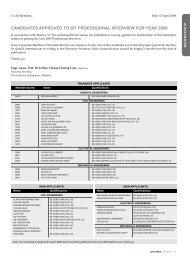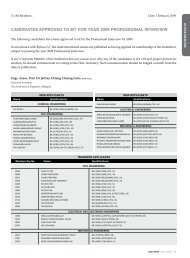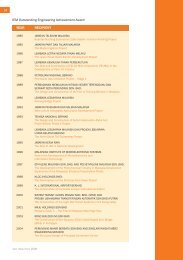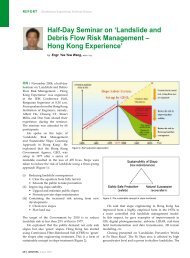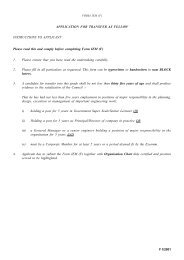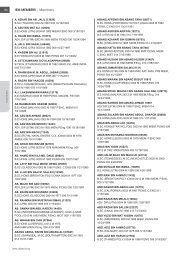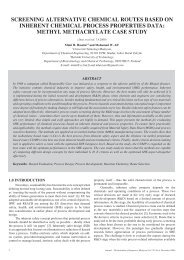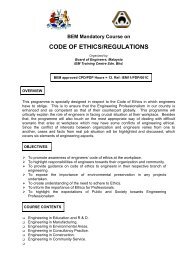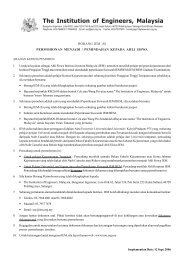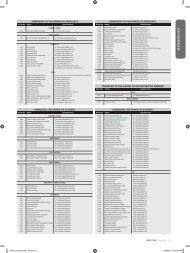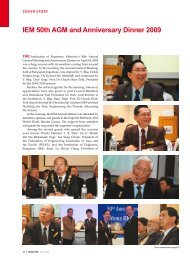InvestIgatIon of transIent Performance of caPacItor voltage transformer
InvestIgatIon of transIent Performance of caPacItor voltage transformer
InvestIgatIon of transIent Performance of caPacItor voltage transformer
You also want an ePaper? Increase the reach of your titles
YUMPU automatically turns print PDFs into web optimized ePapers that Google loves.
Investigation <strong>of</strong> Transient <strong>Performance</strong> <strong>of</strong>Capacitor Voltage Transformer (CVT)(Date received: 19.2.2008)Associated Pr<strong>of</strong>. Dr Saad Mekhilef 1 , Mr. Cheng Hock Lim 2 and Dr Ab. Halim Abu Bakar 31,2,3Department <strong>of</strong> Electrical Engineering,University <strong>of</strong> Malaya, 50603 UM, Kuala LumpurE-mail: saad@um.edu.my. 1abstractThis paper reports the digital-time domain studies on a typical 132kV Capacitor Voltage Transformer (CVT) model. The transientstudies are conducted using Alternative Transient Program (ATP-EMTP). Simulation results corresponding to the CVT transientresponse under both system fault and ferroresonance condition are reported in this paper. Transient studies are performed (1) toidentify the CVT components that contribute to the transient response <strong>of</strong> CVT, (2) to determine system condition that affect the CVTtransient response. A lightning simulation case study is also presented to demonstrate the ferroresonance oscillation sustainedinside a CVT due to lightning strike as affected by the factors <strong>of</strong> lightning current amplitude and distance between CVT andlightning arrester.Keywords: ATP-EMTP, CVT and Ferroresonance1.0 INTRODUCTIONCapacitive Voltage Transformers (CVTs) are thepredominant source <strong>of</strong> <strong>voltage</strong> signals for monitoring, protectionrelays and control application at transmission and subtransmission<strong>voltage</strong> level. For the past few years, electric utility in Malaysiahas reported a big number <strong>of</strong> CVT failures and explosions inthe substations. These have affected the reliability <strong>of</strong> the powersystem [1-4].Theoretically, the output waveform <strong>of</strong> a CVT should be anexact replica <strong>of</strong> the input waveform under all operating systemconditions [5-8]. This requirement can easily be satisfied understeady-state condition. However, electric power systems aresubjected to many types <strong>of</strong> disturbances that results in electrictransients due to lightning, system fault, line energization anddeenergisation, switching <strong>of</strong> inductive or capacitive load. Undersuch transient conditions, the CVT output waveform may notfollow closely to its input waveform due to internal storageelements such as capacitive, inductive and non-linear components(saturable magnetic core) <strong>of</strong> the CVT [9-12]. They take time todissipate their stored energy. Electromechanical relays can copewith unfavorable CVT transients due to their natural mechanicalinertia at the expense <strong>of</strong> slower operation. Digital relays aredesigned for high-speed tripping and therefore they face certainCVT related transient problem [13-15].The phenomenon <strong>of</strong> ferroresonance is <strong>of</strong> particular concernduring CVT transients because it may cause thermal overstressand consequently deterioration <strong>of</strong> CVT components due totransient over<strong>voltage</strong>s produced inside the CVT. The transienterrors produced can have major impact on the dependabilityand security <strong>of</strong> the protective relay which may affect the overallprotection performance [16].44In order to have a better access to the above issues, a thoroughinvestigation <strong>of</strong> the CVT transient performance is needed. In thiswork, a typical 132kV CVT model to be used in connection withthe ATP-EMTP is presented. Digital time domain simulationscorresponding to system fault and ferroresonance condition arecarried out. The objectives <strong>of</strong> this work are (1) to identify theCVT transients’ contribution factors, and (2) to investigate theimpact <strong>of</strong> power system transient e.g. system faults and lightningon the transient performance <strong>of</strong> CVT [17-19].Lightning stroke near the high <strong>voltage</strong> (H.V.) transmissionline is one <strong>of</strong> the most common transient disturbances foundin high <strong>voltage</strong> substation. The transient disturbances alwaystransmitted through instrument <strong>transformer</strong> to the complexand distributed protection circuit, connected at their secondaryterminals and seriously affect their workings [20-23]. To realisethe above problem, a lightning case study was carried out toinvestigate the ferroresonance oscillations sustained inside aCVT, which are <strong>of</strong> serious concern, predominantly because <strong>of</strong>causing possible damage to CVT.2.0 CVT MODELFigure 1 shows the circuit diagram <strong>of</strong> the typical 132kVCVT model used for the studies. Switches S1 and S2 are notpart <strong>of</strong> the CVT circuitry, it’s included in the model to simulatevarious transient scenarios imposed on the CVT.Basically, the CVT model is composed <strong>of</strong> CapacitiveVoltage Divider (C1 and C2), Step-down Transformer (SDT),Compensating Series Reactor (SR), Ferroresonance SuppressionCircuit (Cf, Rf, Lf), and Over<strong>voltage</strong> Protection devices (Vgap,Rgap).Journal - The Institution <strong>of</strong> Engineers, Malaysia (Vol. 71, No.2, June 2009)
Saad MekhilefFigures 3(a) and 3(b) show the CVT response t<strong>of</strong>erroresonance test when series burden with power factor <strong>of</strong>0.2 and 0.8 is included on the secondary winding <strong>of</strong> the CVTas load respectively. By comparing both figures, it is obviousthat ferroresonance is more effectively damped out for load withhigher power factor. Hence, it is fair to say that higher powerfactor burden gives better transient response.Figure 4(b) : Passive ferroresonance suppression circuitFigures 5(a) and 5(b) show the transient response <strong>of</strong> theCVT with AFSC and CVT with PSFC respectively. Note that theCVT with a PFSC has a better, less distorted transient response(lower <strong>voltage</strong> spike) as compare CVT with an AFSC.(a)(a)(b)(b)Figure 3 : CVT output <strong>voltage</strong> response to ferroresonance testfor series burden <strong>of</strong> 200VA (a) power factor = 0.2, and (b) powerfactor = 0.8.Case 2: Ferroresonance Suppression CircuitThis case investigates the effect <strong>of</strong> ferroresonancesuppression circuit (FSC) on the CVT transient performance.FSC is designed to avoid dangerous and destructive over<strong>voltage</strong>scaused by ferroresonance. It loads a CVT and creates an extrapath- apart from the burden – for dissipating energy. A specificdesign <strong>of</strong> FSC is <strong>of</strong>ten treated as proprietary information and isseldom available. However, two generic models <strong>of</strong> FSC that arecommonly used in CVT will be considered here. They are theactive ferroresonance circuit (ASFC) and passive ferroresonancecircuit (PFSC) as shown in Figures 4(a) and 4(b) respectively.Figure 4(a) : Active ferroresonance suppression circuit46Figure 5 : CVT output <strong>voltage</strong> responses for (a) CVT with AFSC and(b) CVT with PSFC3.2 System FaultA simplified equivalent circuit <strong>of</strong> the CVT model as shown inFigure 6 is used to investigate the transient response contributionfactors during a close-in, line-to-ground fault using ATPDrawsimulation. This is imposed by closing and opening switch S1.The tests are carried out under different cases to investigate theeffect <strong>of</strong> CVT components, and system condition on the CVTtransient response.Case 1: Sum <strong>of</strong> Stack CapacitanceThis case investigates the effect <strong>of</strong> the sum <strong>of</strong> stackcapacitance, (CVT component) on the CVT transientperformance.Journal - The Institution <strong>of</strong> Engineers, Malaysia (Vol. 71, No.2, June 2009)



